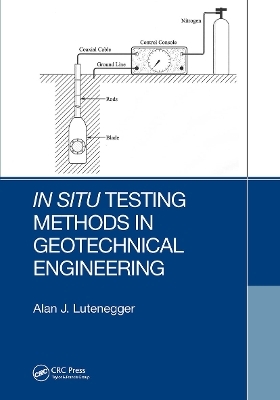
In Situ Testing Methods in Geotechnical Engineering
Seiten
2022
CRC Press (Verlag)
978-0-367-75874-5 (ISBN)
CRC Press (Verlag)
978-0-367-75874-5 (ISBN)
In situ testing methods are commonly used by geotechnical engineers to determine subsurface stratigraphy and soil characteristics for design. This book presents the latest technology on the correct methods for performing a variety of in situ tests and the correct methods of interpreting the results obtained from the tests.
In Situ Testing Methods in Geotechnical Engineering covers the field of applied geotechnical engineering related to the use of in situ testing of soils to determine soil properties and parameters for geotechnical design. It provides an overview of the practical aspects of the most routine and common test methods, as well as test methods that engineers may wish to include on specific projects. It is suited for a graduate-level course on field testing of soils and will also aid practicing engineers.
Test procedures for determining in situ lateral stress, strength, and stiffness properties of soils are examined, as is the determination of stress history and rate of consolidation. Readers will be introduced to various approaches to geotechnical design of shallow and deep foundations using in situ tests. Importantly, the text discusses the potential advantages and disadvantages of using in situ tests.
In Situ Testing Methods in Geotechnical Engineering covers the field of applied geotechnical engineering related to the use of in situ testing of soils to determine soil properties and parameters for geotechnical design. It provides an overview of the practical aspects of the most routine and common test methods, as well as test methods that engineers may wish to include on specific projects. It is suited for a graduate-level course on field testing of soils and will also aid practicing engineers.
Test procedures for determining in situ lateral stress, strength, and stiffness properties of soils are examined, as is the determination of stress history and rate of consolidation. Readers will be introduced to various approaches to geotechnical design of shallow and deep foundations using in situ tests. Importantly, the text discusses the potential advantages and disadvantages of using in situ tests.
Dr Alan J. Lutenegger is Emeritus Professor of Geotechnical Engineering at the University of Massachusetts-Amherst, USA.
1 Introduction to In Situ Testing 2 Standard Penetration Test (SPT) 3 Dynamic Cone Penetration Test (DCP) 4 Cone Penetration (CPT) and Piezocone (CPTU) Tests 5 Field Vane Test (FVT) 6 Dilatometer Test (DMT) 7 Pressuremeter Test (PMT) 8 Borehole Shear Test (BST) 9 Plate Load Test (PLT) and Screw Plate Load Test (SPLT) 10 Other In Situ Tests
| Erscheinungsdatum | 23.11.2022 |
|---|---|
| Zusatzinfo | 94 Tables, black and white; 181 Line drawings, black and white; 9 Halftones, black and white |
| Verlagsort | London |
| Sprache | englisch |
| Maße | 178 x 254 mm |
| Gewicht | 453 g |
| Themenwelt | Naturwissenschaften ► Geowissenschaften ► Geologie |
| Naturwissenschaften ► Geowissenschaften ► Geophysik | |
| Technik ► Bauwesen | |
| Technik ► Umwelttechnik / Biotechnologie | |
| ISBN-10 | 0-367-75874-1 / 0367758741 |
| ISBN-13 | 978-0-367-75874-5 / 9780367758745 |
| Zustand | Neuware |
| Informationen gemäß Produktsicherheitsverordnung (GPSR) | |
| Haben Sie eine Frage zum Produkt? |
Mehr entdecken
aus dem Bereich
aus dem Bereich
Baugruben und Gründungen
Buch | Hardcover (2024)
Springer Fachmedien Wiesbaden GmbH (Verlag)
CHF 83,95


